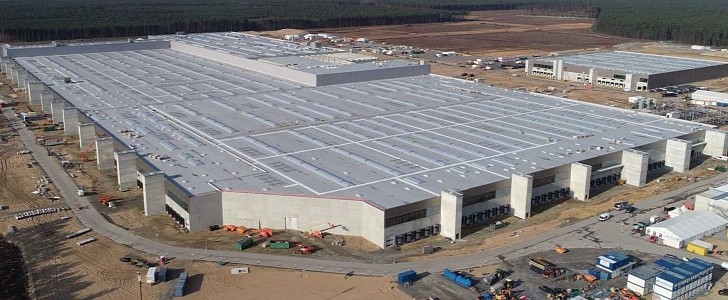Tesla received authorization to produce 250 Model Y bodies in its new German factory in Grünheide last fall. LfU (Landesamt für Umwelt, or State Office for the Environment) allowed it to test manufacturing there, but these first units would have presented poor quality. Tesla asked to produce more, and LfU allowed it to make up to 2,000 EVs. However, there’s a catch: all of them will have to be scrapped.
This is what MOZ.de revealed back on January 8. According to the German website, the authorization documents allow Tesla to test the press shop, body shop, paint shop, and final assembly in the next eight weeks, meaning the texts can extend until the beginning of March. Tesla may paint up to 500 bodies per week in its “revolutionary” paint shop.
Frequent cases of paint issues in its vehicles made Tesla announce the paint shop at Giga Grünheide to be its most advanced one, thanks to Geico Taikisha. With a robotic quality inspection called J-Detect, the Smart Paint Shop may ensure owners will not complain about peeling paint anymore.
The information that the first bodies made at Giga Grünheide presented poor quality came from BZ-Berlin. That German website also said that Jörg Steinbach, Brandenburg’s Finance minister, is pretty confident that the factory will get the final permit soon. Steinbach said the same last year.
MOZ.de stressed that the document does not define what it means by “bodies.” It could be just the body-in-white or a complete car. We’d bet on the first hypothesis, especially considering the restrictions imposed by the Brandenburg government.
According to the document, none of the vehicles produced can be sold. Tesla may not seize parts from them to use in production cars. Everything has to be scrapped, and the EV maker will have to prove that. If Tesla prefers to throw some components away instead of destroying them, it has to provide appropriate evidence that it did so.
BZ-Berlin calculated that 2,000 cars sold at €63,000 would mean Tesla would have to burn €126 million ($143,2 million at the current exchange rate) in these tests. However, there are some flaws to this calculation. First of all, Tesla is allowed to produce this many vehicles, but it does not mean it will. With expensive components that are in short supply, such as battery packs, scrapping them would be terrible. Tesla should just test what it needs and avoid waste as much as possible.
The second issue with BZ-Berlin’s calculation is that €63,000 ($71,600) is the price for the Model Y Performance in Germany. The Long Range costs €57,970 ($65,815), including shipping fees. Tesla should select the more affordable vehicle for the tests: they are very much the same car apart from a few different components, such as the electric motors.
Potentially, Tesla’s tests could cost €115,94 million ($131.8 million) only in the cars it could have to destroy if they are complete vehicles and not just bodies-in-white. In practice, the company will probably spend a lot less in the process. Just remember the issues Tesla is having for not testing its cars enough, such as the Model 3 recall and the heating issue with vehicles equipped with heat pumps.
Frequent cases of paint issues in its vehicles made Tesla announce the paint shop at Giga Grünheide to be its most advanced one, thanks to Geico Taikisha. With a robotic quality inspection called J-Detect, the Smart Paint Shop may ensure owners will not complain about peeling paint anymore.
The information that the first bodies made at Giga Grünheide presented poor quality came from BZ-Berlin. That German website also said that Jörg Steinbach, Brandenburg’s Finance minister, is pretty confident that the factory will get the final permit soon. Steinbach said the same last year.
MOZ.de stressed that the document does not define what it means by “bodies.” It could be just the body-in-white or a complete car. We’d bet on the first hypothesis, especially considering the restrictions imposed by the Brandenburg government.
According to the document, none of the vehicles produced can be sold. Tesla may not seize parts from them to use in production cars. Everything has to be scrapped, and the EV maker will have to prove that. If Tesla prefers to throw some components away instead of destroying them, it has to provide appropriate evidence that it did so.
BZ-Berlin calculated that 2,000 cars sold at €63,000 would mean Tesla would have to burn €126 million ($143,2 million at the current exchange rate) in these tests. However, there are some flaws to this calculation. First of all, Tesla is allowed to produce this many vehicles, but it does not mean it will. With expensive components that are in short supply, such as battery packs, scrapping them would be terrible. Tesla should just test what it needs and avoid waste as much as possible.
The second issue with BZ-Berlin’s calculation is that €63,000 ($71,600) is the price for the Model Y Performance in Germany. The Long Range costs €57,970 ($65,815), including shipping fees. Tesla should select the more affordable vehicle for the tests: they are very much the same car apart from a few different components, such as the electric motors.
Potentially, Tesla’s tests could cost €115,94 million ($131.8 million) only in the cars it could have to destroy if they are complete vehicles and not just bodies-in-white. In practice, the company will probably spend a lot less in the process. Just remember the issues Tesla is having for not testing its cars enough, such as the Model 3 recall and the heating issue with vehicles equipped with heat pumps.









